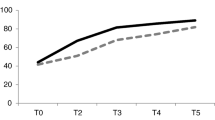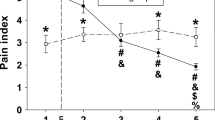Abstract
Aim
Patient’s satisfaction after total hip arthroplasty is influenced by many surgical and rehabilitation aspects, but is not available in the literature, a study that analyses the correlation between patient’s psychology and clinical results of this procedure. The aim of this study was to investigate the relationship between memory of pain, clinical outcome and subjective satisfaction with the Multidimensional Health Locus of Control.
Methods
We conducted a cross-sectional study on a cohort of 69 patients operated of total hip arthroplasty in our department from November 2008 to August 2011. Pre- and post-operative hip function was assessed by the Harris Hip Score. At the follow-up visit, patient satisfaction was assessed by means of the Patient Satisfaction Questionnaire. The memory of pain was evaluated by a modified questionnaire of pain experience. Multidimensional Health Locus of Control was evaluated in all patients, and results were connected with patient’s subjective satisfaction and pain indexes.
Results
Patients were divided into two groups about patient satisfaction, those with GPS > 15 and those with GPS ≤ 15. Patients very satisfied showed a significantly higher mean value of IHLC. Regarding pain experience, patients were divided into two categories: those recalling less pain with OvP score ≤11 (Q1 < 3, avg. score Q2–Q4 ≤ 3) and those recalling more pain with OvP score >11. IHLC score resulted significantly higher in patients recalling less pain.
Discussion
Multidimensional Health Locus of Control can be considered a predictor of patient’s satisfaction after an invasive surgical procedure as total hip arthroplasty.
Similar content being viewed by others
References
Greenhalgha J, Longa AF, Flynnb R (2005) The use of patient reported outcome measures in routine clinical practice: Lack of impact or lack of theory? Soc Sci Med 60:833–843
Franklin PD, Lewallen D, Bozic K, Hallstrom B, Jiranek W, Avers DC (2014) Implementation of patient-reported outcome measures in U.S. total joint replacement registries: rationale, status, and plans. J Bone Joint Surg Am 96(Suppl 1):104–109
Black N (2013) Patient reported outcome measures could help transform healthcare. BMJ 346:167
Masters KS, Wallston KA (2005) Canonic correlation reveals important relations between health locus of control, coping, affect and values. J Health Psychol 10(5):719–731
Wallston BS, Wallston KA, Kaplan GD, Maides SA (1976) The development and validation of the health related locus of control (HLC) scale. J Consult Clin Psychol 44:580–585
Wallston KA, Wallston BS, DeVellis R (1978) Multidimensional health locus of control (MHLC) Scales. Health Educ Monogr 6:160–170
Affleck G, Tennen H, Pfeiffer C, Fifield J, Rowe J (1987) Downward comparison and coping with serious medical problems. Am J Orthopsychiatry 57(4):570–578
Nyland J, Cottrell B, Harreld K, Caborn DNM (2006) Self-reported outcomes after anterior cruciate ligament reconstruction: an internal health locus of control score comparison. Arthroscopy 22(11):1225–1232
Charnley J (1972) The long-term results of low-friction arthroplasty of the hip performed as a primary intervention. J Bone Joint Surg (Br) 54(1):61–76
Harris WH (1969) Traumatic arthritis of the hip after dislocation and acetabular fractures: treatment by mold arthroplasty. An end-result study using a new method of result evaluation. J Bone Joint Surg Am 51(4):737–755
Awanake EA, Jenkins PJ, Moran M (2013) Predicting dissatisfaction after total hip arthroplasty: a study of 850 patients. J Arthoplasty 26(2):209
Browne A, Andrews R, Bpsych, Schug SA, Wood F (2011) Persistent pain outcomes and patient satisfaction with pain management after burn injury. Clin J Pain 27(2):136–145
Michiel GJS, Hageman MGJS, Briet JP, Bossen JK, Blok R, Ring DC, Vranceanu A-M (2015) Do previsit expectations correlate with satisfaction of new patients presenting for evaluation with an orthopaedic surgical practice? Clin Orthop Relat Res 473:716–721
Hickson GB, Clayton EW, Entman SS, Miller CS, Githens PB, Whetten-Goldstein K, Sloan FA (1994) Obstetricians’ prior malpractice experience and patients’ satisfaction with care. JAMA 272:1583–1587
Graham B, Green A, James M, Katz J, Swiontkowski M (2015) Measuring patient satisfaction in orthopaedic surgery. J Bone Joint Surg Am 97:80–84
Nyland J, Mauser N, Caborn DM (2013) Sports involvement following ACL reconstruction is related to lower extremity neuromuscular adaptations, subjective knee function and health locus of control. Knee Surg Sports Traumatol Arthrosc 21:2019–2028
Nyland J, Cottrell B, Harreld K, Caborn DNM (2006) Self-reported outcomes after anterior cruciate ligament reconstruction: an internal health locus of control score comparison. Arthroscopy 22(11):1225–1232
Keedy NH, Keffala VJ, Altmaier EM, Chen JJ (2014) Health locus of control and self-efficacy predict back pain rehabilitation outcomes. Iowa Orthop J 34:158–165
Gustafsson M, Gaston-Johansson F (1996) Pain intensity and health locus of control: a comparison of patients with fibromyalgia syndrome and rheumatoid arthritis. Patient Educ Couns 2:179–188
Author information
Authors and Affiliations
Corresponding author
Ethics declarations
Conflict of interest
None.
Rights and permissions
About this article
Cite this article
Trevisan, C.L., Klumpp, R., Recalcati, W. et al. Influence of personality psychology on outcome of total hip arthroplasty: a cross-sectional study on 69 patients. Musculoskelet Surg 99, 231–236 (2015). https://doi.org/10.1007/s12306-015-0381-0
Received:
Accepted:
Published:
Issue Date:
DOI: https://doi.org/10.1007/s12306-015-0381-0




